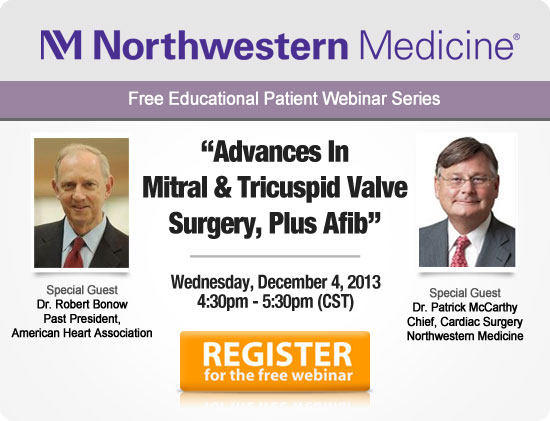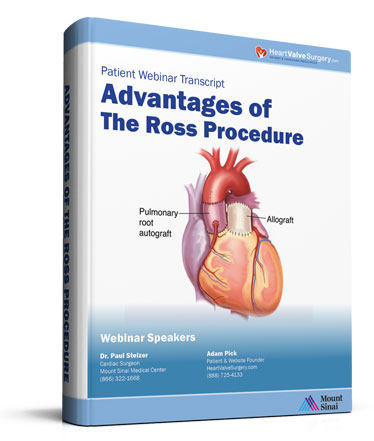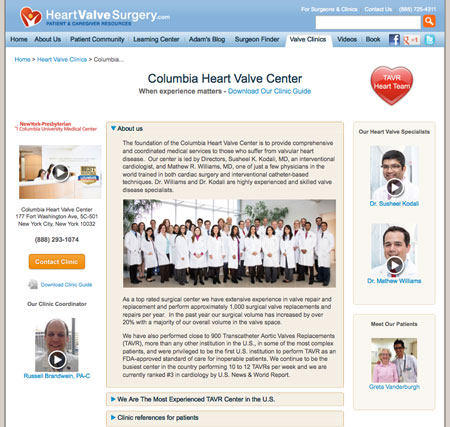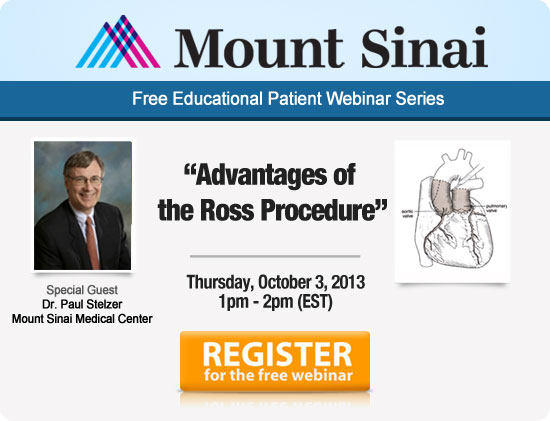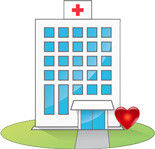Adam's Heart Valve Surgery Blog – Page 32
Video Update: After Complex Heart Valve & Atrial Fibrillation Surgery, Clarissa Is Doing Great!
By Adam Pick on December 4, 2013
I recently met Clarissa Alaimo, a 53-year old patient from Lake Forest, Illinois.
Like many patients, Clarissa suffered from shortness of breath and fatigue due to several cardiac issues including mitral stenosis, tricuspid regurgitation and atrial fibrillation. So you know, Clarissa experienced rheumatic fever years ago.
To help you learn more about Clarissa and her complex surgery, I created this patient success story video. For the hearing impaired members of our community, I have provided a written transcript below.
Many thanks to Clarissa for taking the time to be interviewed for this video. I also want to thank Dr. McCarthy, Dr. Vassallo and the Northwestern team for taking such great care of Clarissa.
Join Over 200 Patients & Caregivers For Wednesday’s Webinar!
By Adam Pick on December 3, 2013
Great news everybody!
I just learned that over 200 patients and caregivers have registered for our webinar, “Advances in Mitral & Tricuspid Valve Surgery; Plus, Atrial Fibrillation” with Dr. Robert Bonow, past president of the American Heart Association, and Dr. Patrick McCarthy, chief of cardiac surgery at Northwestern Memorial Hospital. The webinar will be held this Wednesday — from 4:30 to 5:30pm CST.
Given the response to this event, we just extended the webinar registration. So, if you would like to participate in this special community event, simply click here. There is no fee to join the webinar and all you need is a computer to attend the event.
FYI… Here are answers to a few questions I’ve received about the webinar:
Question 1 – Can I Still Register For The Webinar?
Yes, you can still register for the event. To sign-up for the webinar, click here.
Special Announcement: Dr. Bonow & Dr. McCarthy to Host Live Webinar for Patients on December 4
By Adam Pick on November 25, 2013
I am very excited to announce that Dr. Robert Bonow, past president of the American Heart Association, and Dr. Patrick McCarthy, chief of cardiac surgery at Northwestern Memorial Hospital, will be hosting a special one-hour webinar on Wednesday, December 4, at 4:30pm CST.
The webinar, “Advances in Mitral & Tricuspid Valve Surgery: Plus, Atrial Fibrillation”, will provide special insights into valvular disease and treatment. Drs. Bonow and McCarthy will also address a common condition among patients at our website… atrial fibrillation.
More good news… The webinar is free for everybody. To register now, click here.
I forgot to mention… During the webinar, you will have an opportunity to ask Drs. Bonow and McCarthy questions in real-time. That said, this is an excellent opportunity to get your questions answered about heart valve disease and atrial fibrillation.
So you know, Dr. Robert Bonow, is a world-renown cardiologist who specializes in medical treatment for valve disease and a past chair of the American College of Cardiology / American Heart Association Task Force of Practice Guidelines of Patients with Valvular Disease. Dr. Patrick McCarthy is a heart valve guru having performed over 10,000 cardiac procedures. Currently, Dr. McCarthy is the #1 recommended heart valve surgeon at our Surgeon Finder tool.
Keep on tickin!
Adam
Traveling Timeline After Heart Surgery
By Adam Pick on November 25, 2013
Travel during the holiday season is expected to increase this year, up from the 93.3 million travelers who ventured at least 50 miles away from home this time last year, according to AAA. Although many medical professionals recommend avoiding traveling during recovery, it seems practically unavoidable during this family-centered season. However, just because you might be going against this advice, it doesn’t mean you should throw all caution to the wind. These tips break down some important considerations for traveling after heart surgery.

Two weeks
The National Health Service recommends checking with your airline BEFORE flying, since companies have varying regulations on post-surgery travelers. However, the Civilian Aviation Authority says that 10 to 14 days is sufficient after chest surgery or a coronary artery bypass graft. After any heart operation, patients should remain moderately active to keep the heart pumping. Avoid tight clothing to prevent circulation inhibition as well.
The Challenges of Adopting Transcatheter Valve Devices in the United States with Dr. Ziyad Hijazi
By Adam Pick on November 22, 2013
During the past 24 months, the Food & Drug Administration (FDA) has approved two transcatheter valve therapies — the SAPIEN and the MitraClip — for select patient populations in the United States. While these FDA approvals represent significant progress in the adoption of transcatheter valve technologies, I’ve met with several physicians and patients who continue to be frustrated by the relatively slow path by which next generation devices becomes available in America.
To learn more about the challenges and opportunities of adopting transcatheter valve therapy in the United States, I recently interviewed Dr. Ziyad Hijazi, a leading interventional cardiologist, from Rush Medical Center in Chicago, Illinois. Here are the highlights of my conversation with Dr. Hijazi.
Brian’s Guest Post: Life Beyond Heart Valve Surgery, Pulling Together a Running Team
By Adam Pick on November 21, 2013
When I joined Heart Valve Journals in September of 2012, I had really one thing in mind, “Could I continue running til surgery and after surgery would I be back to where I was at?” In June, I was told that I needed to have surgery but decided not to fully believe that since I had no symptoms that I could see and was running 20-30 miles a week, completed a half marathon just months before and was planning a full marathon in November.
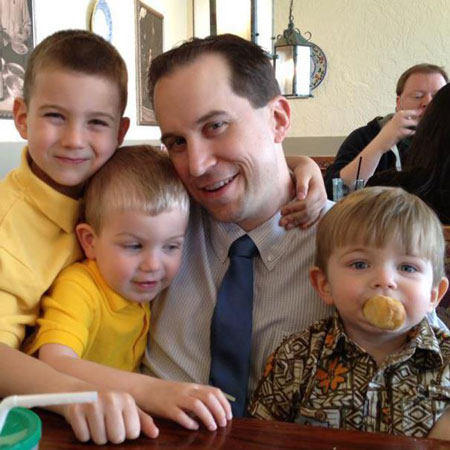
Brian & His Three Sons
Well, it came to reality in October and November when my Internal Cardiac Device (ICD) Defibrillator sent a shock through my body from my heart hitting over 180 and then 190 beats per minute. As I reflected back on my journal entries, I remember this time too well. This was the reality check I needed and the time I needed to talk it out with my wife to give me the peace to go ahead and get this surgery behind me. The encouragement from this website was something I really needed as people I did not know reached out through the guestbook, provided information and I read story after story about success from others.
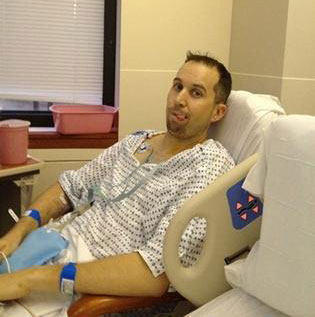
Brian 3 days after surgery, loving being photographed in my gown
Now, here I am almost 1 year from my surgery and back at full strength in my running, preparing for my first half marathon since surgery in April and trying to give back to this great community in any way I can. I know there are many other passionate runners out here, some pre-surgery, some in recovery and many post surgery. I already have a list of a few, Scott Newson, Mitch Friedman, Jim Jones, Peter Woglom, and John O’Neil. Now, I want to get more and give back to the heart community as a whole, so here is the plan.
MitraClip Gets FDA Approval: 5 Facts You Need To Know
By Adam Pick on November 19, 2013
In case you missed it… The MitraClip just received a Food & Drug Administration (FDA) approval in the United States. This is REALLY big news as the MitraClip is now the first-and-only transcatheter valve therapy for patients with leaking mitral valves, also known as regurgitation. Using the MitraClip, physicians can treat defective mitral leaflets without causing any trauma to the patient’s sternum or ribs. Yep, you read that right. No cracked bones!
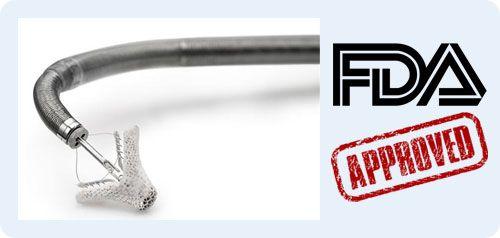
To educate our patient community about the significant implications of the MitraClip’s FDA approval, I contacted Dr. Scott Lim, a leading interventional cardiologist at the UVA Advanced Cardiac Valve Center at the University of Virginia. As you might recall, I saw Dr. Lim perform a MitraClip procedure a few years ago. To date, Dr. Lim’s team has performed over 100 MitraClip procedures.
Medical Mission Update: In The Dominican Republic, Four Patients Get A “Second Chance” At Life
Written By: Adam Pick, Patient Advocate, Author & Website Founder
Published: November 8, 2013
I recently traveled from Los Angeles to the Dominican Republic for a medical mission to treat patients with heart valve disease. Since I had never been on a mission, I didn’t know what to expect. After the mission, I can share that this five-day event altered my perception of human kindness. I was touched, moved and inspired by the patients, their families, the nurses and the doctors who came together for this extraordinary mission.
While in Santo Domingo, I saw four patients get a “second chance” at life. While in Santo Domingo, I saw three medical teams — Mount Sinai Hospital, Piedmont Heart Institute and Hospital General de la Plaza de la Salud — achieve surgical success. While in Santo Domingo, I also had a camera and a microphone which captured several beautiful moments on film. That said, I created the video below to share this experience with you.
On behalf of the patients, their families and friends, I would like to thank the Mitral Foundation for organizing and financially supporting this mission. In particular, I would like to thank Dr. David Adams, Dr. Ricardo Lazala and Gideon Sims for inviting me to Santo Domingo for the mission. I would also like to thank each person from The Mount Sinai Hospital and Piedmont Heart Institute teams including Dr. Gregory Fischer, Dr. Fred Lajam, Dr. Federico Milla, Dr. John Gott, Juan Obando and Mary Joy Santillan.
Minimally Invasive Specialist, University of Virginia Advanced Cardiac Valve Center, Launches Microsite!
By Adam Pick on November 7, 2013
In 2010, I was very lucky to tour the UVA Advanced Cardiac Valve Center at the University of Virginia in Charlottesville. During my visit, I observed a transcatheter MitraClip procedure performed by Dr. Scott Lim and Dr. Gorav Ailawadi. Since then, I have met several other members of the UVA team — including Dr. Irving Kron and Dr. John Kern. Together, this team of dedicated cardiologists and surgeons has treated many patients in our community like Robert Elliot, Todd Breeden and Susan Houk.
For these reasons, I am very excited to announce that the UVA Advanced Cardiac Valve Center just launched a Heart Valve Clinic Microsite at HeartValveSurgery.com. So you know, the University of Virginia provides patients many options for valvular care. As a complement to its traditional surgical approaches, the UVA team has also pioneered and participated in several clinical trials for minimally invasive techniques include transcatheter aortic valve replacement and mitral valve repair.
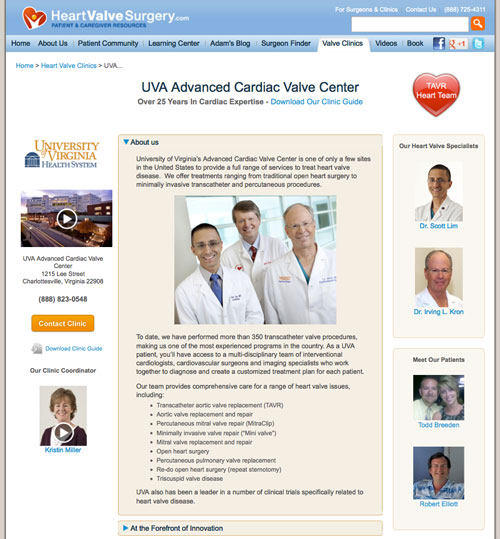
On behalf of the patient and caregiver community at HeartValveSurgery.com, I would like to thank all of the members of the UVA Advanced Cardiac Valve Center for its support of our website — with a special thanks to Dr. Kron, Dr. Lim, Dr. Kern, Dr. Ailawadi, Meghan Bradley, Adam Printy and Ginger Aylor.
Keep on tickin!
Adam
Surgeon Q&A: The Rise of Tricuspid Heart Valve Surgery with Dr. McCarthy
By Adam Pick on November 5, 2013
You may have noticed that most patients in our community have been diagnosed with an aortic or mitral valve disorder. Recently, however, I’ve been contacted by several patients who have tricuspid valve defects.
As the tricuspid valve is often called the “forgotten valve” in medical literature, I wanted to help all patients learn more about the rise of tricuspid valve surgery. For that reason, I just filmed an educational video with Doctor Patrick McCarthy, a tricuspid valve surgeon from Northwestern Medicine.
I hope this video helped you learn more about the increase in tricuspid valve treatment in isolated cases and in concomitant mitral valve repair procedures. To learn more about tricuspid valve surgery, I encourage you to read “Evolving Trends in Tricuspid Valve Surgery”, an excellent research paper by Doctor McCarthy.
John Fox, Denver Broncos Head Coach, Scheduled for Aortic Valve Replacement
By Adam Pick on November 3, 2013
Since launching this website in 2006, I have followed the heart valve procedures of many public figures including Robin Williams, Barbara Walters, Ed Koch, and Barbara Bush.
Yesterday, we learned that John Fox, the head coach of the Denver Broncos, is scheduled for an aortic valve replacement surgery on Tuesday. Coach Fox, who was aware of his valvular disorder, was planning to undergo surgery during the football off-season.
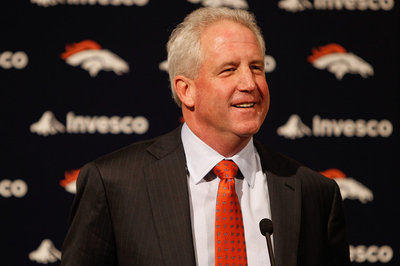 John Fox, Denver Broncos Head Coach, Heart Valve Surgery Patient
John Fox, Denver Broncos Head Coach, Heart Valve Surgery Patient
However, on Saturday, Fox began experiencing symptoms while playing golf with his friends. Shortly thereafter, Fox was brought to a hospital, where an ultrasound revealed he needed aortic valve surgery as soon as possible. (So you know, the early news reports that Coach Fox had a heart attack were incorrect.)
Caregiving After Heart Surgery: 5 Tips for a Speedy, Healthy Recovery
By Adam Pick on October 30, 2013
Going in for surgery is not easy, but it can be equally challenging on the caregiver as on the patient. Post-op care requires patience, compassion and a bit of basic medical knowledge to smooth your loved one’s journey after heart surgery.
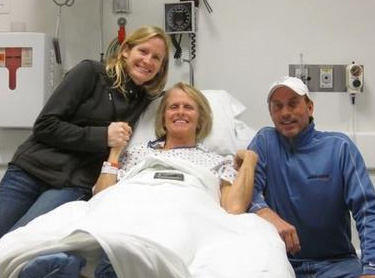 Deb Ziegler, Mitral & Tricuspid Valve Patient, with Josie & Jim
Deb Ziegler, Mitral & Tricuspid Valve Patient, with Josie & Jim
1. Figure Out the Patient’s Preferences BEFORE Surgery
As with many aspects of a relationship, communication about surgery expectations is key. Don’t wait until your loved one is recuperating on a couch to find out what he or she needs. Instead, have a detailed discussion in the days or weeks leading to the surgery. Does the patient want visitors after arriving home? What types of foods make him feel best when she’s sick? Do books, movies or video games relax him? Discuss these aspects of post-surgical care before the operation to ensure you’re both on the same page.
Patient Success Story: After TAVR Procedure, John Gerlits Is Out Of The Hospital In Two Days!
By Adam Pick on October 25, 2013
Recently, I met John Gerlits, a patient diagnosed with aortic valve stenosis four years ago. As John had a history of heart disease, he qualified for the new transcatheter aortic valve replacement (TAVR) procedure. If you didn’t know, TAVR is a minimally invasive procedure in which the aortic valve is replaced without an incision to the patient’s sternum or ribs.
To help patients in our community learn more about John, I created this educational video. In the video, you will also hear from John’s physicians — Dr. Chris Malaisrie, cardiac surgeon, and Dr. James Flaherty, interventional cardiologist — about the use of TAVR for inoperable and high risk patients. For the hearing impaired members of our community, I have provided a written transcript of this video below.
Free eBook & Video: “Advantages of the Ross Procedure” Webinar
By Adam Pick on October 17, 2013
Great news!
Our recent webinar, “Advantages of the Ross Procedure”, went really well. Over 140 patients and caregivers registered to learn critical insights about aortic valve disease and treatment from Dr. Paul Stelzer, a leading cardiac surgeon at Mount Sinai Hospital in New York. In particular, the webinar focused on the advantages of the Ross Procedure for patients with valve defects including aortic stenosis and aortic regurgitation.
If you were unable to attend the webinar, no worries. I created two ways you can access the information shared during this hour-long event with Dr. Stelzer. You can either:
Technology Update: The Two-Part Vitality Heart Valve Replacement Explained by Ivan Vesely, Founder of ValveXchange
By Adam Pick on October 15, 2013
New heart valve companies don’t pop up often. The last time there was an innovation rush in this field was about 10 years ago, when several transcatheter heart valve companies were launched to develop valves delivered to the patient’s heart via catheter. Since that time, the Edwards SAPIEN class of products got FDA approval in the United States, and a whole bunch more are being sold in Europe.
As we have previously discussed, TAVR procedures (also known as TAVI) is really great for patients that are high risk or inoperable. But… What about new valve replacement technologies for patients that are not sick enough for transcatheter valves? Well, there really hasn’t been a start-up company — with a unique approach to valve replacement therapy — in years. Then came… ValveXchange.
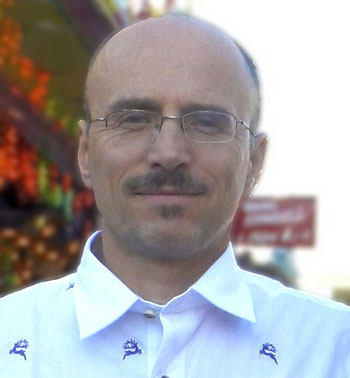 Ivan Vesely, Founder of ValveXchange
Ivan Vesely, Founder of ValveXchange
Originally started by noted heart valve scientist, Ivan Vesely, and having roots in the internationally renowned Cleveland Clinic, ValveXchange is a development-stage, Colorado-based company that is making waves with it’s two-part valve platform.
To learn more about ValveXchange and its potential implications for our patient community, I interviewed Ivan Vesely, its founder.
TAVR Specialist, Columbia Heart Valve Center, Launches Microsite!
By Adam Pick on October 13, 2013
I am very happy to announce that the Columbia Heart Valve Center just launched a Heart Valve Clinic Microsite at HeartValveSurgery.com. Needless to say, we are thrilled to be working with Columbia’s incredible team which includes Dr. Craig Smith, Dr. Martin Leon, Dr. Mathew Williams and Dr. Susheel Kodali.
So you know, the Columbia Heart Valve Center, which is located in New York City, is one of the leading transcatheter aortic valve replacement (TAVR) clinics in the United States. Thus far, the Columbia Heart Valve Center has implanted over 900 TAVRs for aortic stenosis patients who are inoperable or at high risk. To learn more about the Columbia Heart Valve Center, please click here.
On behalf of our patient and caregiver community, I would like to thank all of the members of the Columbia Heart Valve Center — with a special thanks to Dr. Williams, Dr. Kodali, Lisa Hathaway, Patricia Knipper, Diane Amato and Deborah Schwarz.
Keep on tickin!
Adam
Join 100 Patients for The Ross Procedure Webinar!
By Adam Pick on October 1, 2013
Great news everybody!
I just learned that over 100 patients have registered for the Ross Procedure Webinar with Dr. Stelzer this Thursday, October 3, at 1pm EST.
That said, we just extended the webinar registration. So, if you would like to participate in this special community event about the Ross Procedure, simply click the link below. There is no cost to join the webinar. All you need is a computer.
Please let me know if you have any questions!
Keep on tickin!
Adam
“Can a Physically Demanding Job Cause an Early Onset of Heart Valve Disease?” Asks Jerry
By Adam Pick on October 1, 2013
I just received an interesting question from Jerry. In his email, Jerry writes, “Adam, I’m 53 and a recent mitral valve repair and aortic valve replacement patient. My question is… Can a physically demanding profession – like wildland firefighting — contribute to, cause an early onset, or accelerate the development of valve disease in a previously healthy person?”
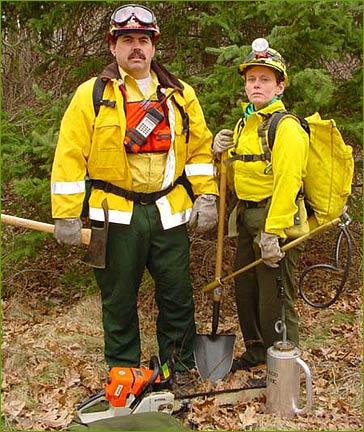
To help Jerry better understand the progression of valvular disease, I contacted Dr. Luis Castro from the Sequoia Hospital Heart & Vascular Institute in Redwood City, California. Doctor Castro offered several interesting thoughts for Jerry that I decided to share with our community. Here is Dr. Castro’s response:
Inside the Operating Room with Dr. Clifton Lewis for a Robotic Mitral Valve Repair & More
By Adam Pick on September 30, 2013
I just experienced something extraordinary.
After putting on scrubs, a cap and a surgical mask, I went inside a cardiac operating room to observe a robotic mitral valve repair surgery. This high-tech procedure was performed by Dr. Clifton Lewis at Princeton Baptist Medical Center in Birmingham, Alabama. If you didn’t know, Dr. Lewis is a minimally invasive specialist that has performed over 8,500 cardiac procedures of which more than 3,500 involved valve repairs or valve replacements.
Needless to say, this experience was… very interesting. On one hand, the patient (who suffered from severe mitral regurgitation due to mitral valve prolapse) did incredibly well. The post-operative echo showed no mitral valve leakage following the procedure. On the other hand, I witnessed first-hand how the million dollar robot enabled Dr. Lewis to reconstruct a mitral valve using an annuloplasty ring and a synthetic chordae — from a remote control panel that was 5 feet away from the operating table.
To share this experience with you, I created this video.
“The robot is really just another surgical instrument,” Dr. Lewis shared with me, “It is under the control of myself and Richard, my physician assistant, who is positioned next to the operating table.” Thus far, Doctor Lewis has performed over 700 robotic mitral valve procedures. He has also used the robot for tricuspid valve repair procedures as well.
Special Announcement: Register Now for the Ross Procedure Webinar Hosted by Dr. Paul Stelzer on October 3
By Adam Pick on September 22, 2013
I am very excited to announce that Dr. Paul Stelzer and I will host a live webinar titled, “The Advantages of the Ross Procedure”, on Thursday, October 3 at 1pm EST. As many of you know, Dr. Stelzer has used the Ross Procedure to treat many patients in our community — including Jeff Shebovsky, Chris Dixon, Mark Kroto, Peter Woglom — that were diagnosed with aortic valve disease.
During this live webinar for patients, their families and friends, Dr. Stelzer is going to discuss aortic valve disease and the different treatment options including the Ross Procedure. Key questions that Dr. Stelzer will address are:
